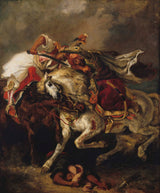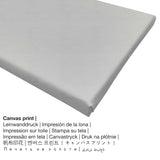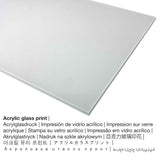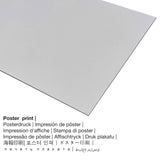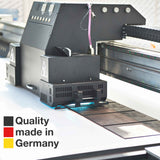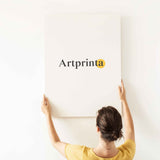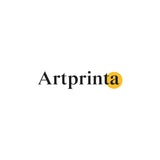Eugène Delacroix, 1835 - Ọgụ nke Giaour na Pasha - mbipụta nka mara mma.
Ụtụ gụnyere. Mbupu gbakọrọ na ndenye ọpụpụ.
Onyinye ngwaahịa
Nke a kariri 180 afọ masterpiece e sere site na nwoke onye na-ese ihe Eugene Delacroix. The original has the following size: Height: 73 cm, Width: 61 cm. Oil painting was used by the French artist as the medium of the artwork. The original masterpiece has the following text as inscrption: Date and signature - Signed and dated lower right: "Eug 1835 Delacroix.". N'oge a, artpiece bụ nke dijitalụ art collection nke Petit Palais - Musée des Beaux-arts de la Ville de Paris, nke bụ ihe ngosi nka nka na mpaghara 8th. Nke nkà nke oge a ọrụ nka, nke bụ akụkụ nke ngalaba ọha a gụnyere ya na nkwanye ùgwù nke Petit Palais Paris.Akụkọ nke ọrụ nka bụ ihe ndị a: . N'elu nke ahụ, nhazi bụ Eserese ya na oke onyonyo nke 1: 1.2, nke pụtara na ogologo bụ 20% mkpụmkpụ karịa obosara. The painter Eugène Delacroix was an artist, whose art style can be classified as Romanticism. The European artist was born in the year 1798 na Saint-Maurice, Val-de-Marne wee nwụọ mgbe ọ dị afọ 65 na 1863 na Paris.
Kedu ihe ga-abụ ihe ebipụta nka kacha amasị gị?
Maka mbipụta nka ọ bụla anyị na-enye ihe & nha dị iche iche. Họrọ n'ime nhọrọ ngwaahịa ndị a ugbu a ka ị kwekọọ na mmasị gị na nha na akụrụngwa:
- Bipụta na enyo acrylic: The acrylic glass print, often described as a fine art print on plexiglass, makes the original into lovely décor. Further, the acrylic art print makes a good alternative option to canvas or aluminium dibond art prints. Your favorite work of art will be manufactured with the help of modern UV printing technology. The major upside of an acrylic glass art print is that contrasts plus smaller image details will be recognizeable due to the precise tonal gradation.
- Mbipụta nke aluminom: An Aluminium Dibond print is a material with a true depth. The bright & white parts of the work of art shimmer with a silk gloss, however without glow. Colors are luminous in the highest definition, fine details are crisp, and there’s a matte appearance that you can literally feel.
- Mpempe akwụkwọ ederede (akwa akwa akwa): Our poster print is a UV printed canvas paper with a fine surface finish. Please bear in mind, that depending on the absolute size of the canvas poster print we add a white margin 2-6cm around the print, which facilitates the framing.
- Mbipụta kanvas: The printed canvas material mounted on a wood stretcher frame. Hanging a canvas print: A canvas print has the great advantage of being relatively low in weight, which implies that it is easy and straightforward to hang up the Canvas print without additional wall-mounts. A canvas print is suited for all types of walls.
Legal note: We do our best in order to describe our products as exact as we can and to display them visually in our shop. Still, the pigments of the printing material and the imprint can diverge somehwat from the representation on the device's screen. Depending on your settings of your screen and the nature of the surface, colors may not be printed as exactly as the digital version on this website. In view of the fact that all art reproductions are printed and processed manually, there might as well be minor differences in the exact position and the size of the motif.
Ozi ihe ahaziri ahazi
| Nkewa edemede: | ọmarịcha nka |
| Mmeputakwa: | dijitalụ mmeputakwa |
| Usoro mmepụta: | Mbipụta UV ozugbo (mbipụta dijitalụ) |
| Ihe ngosi: | German mmepụta |
| Stockdị ngwaahịa: | mmepụta ihe na-achọ |
| Eji ngwaahịa a chọrọ: | ime ụlọ, gallery mgbidi |
| Nhazi: | nhazi ihe osise |
| Njikwa oyiyi: | 1: 1.2 |
| Nkọwa nha onyonyo: | ogologo bụ 20% mkpụmkpụ karịa obosara |
| Akwa ngwaahịa dị: | ígwè ebipụta (aluminium dibond), acrylic glass print (nwere ezigbo mkpuchi iko), mbipụta akwụkwọ mmado (akwụkwọ kwaaji), akwụkwọ akwa akwa. |
| Nhọrọ nha nha mbipụta kanvas (akwa akwa na etiti ihe ndọtị): | 50x60cm - 20x24", 100x120cm - 39x47", 150x180cm - 59x71" |
| Mpempe iko acrylic (nwere ezigbo mkpuchi iko) nha dị iche iche: | 50x60cm - 20x24", 100x120cm - 39x47", 150x180cm - 59x71" |
| Nhọrọ nke mbipụta akwụkwọ mmado (akwụkwọ kwaaji): | 50x60cm - 20x24", 100x120cm - 39x47" |
| Mbipụta aluminom (ihe alumini debond ihe): | 50x60cm - 20x24", 100x120cm - 39x47" |
| Igwe onyonyo: | na-enweghị etiti |
Nkọwa nka ahaziri
| Aha nke ihe nka: | "The Combat of the Giaour and the Pasha" |
| Nhazi nka: | sere |
| Okwu mkpokọta: | nkà nke oge a |
| oge: | 19th narị afọ |
| Afọ okike: | 1835 |
| Afọ nka: | ihe karịrị 180 afọ |
| Ihe osise izizi: | Agba mmanụ |
| Nha izizi (ọrụ nka): | Ogologo: 73 cm, obosara: 61 cm |
| Akara aka na nka nka: | Date and signature - Signed and dated lower right: "Eug 1835 Delacroix." |
| Ụlọ ihe ngosi nka / ebe: | Petit Palais - Musée des Beaux-arts de la Ville de Paris |
| Ebe ngosi nka: | Paris, France |
| Weebụsaịtị nke ihe ngosi nka: | Petit Palais - Musée des Beaux-arts de la Ville de Paris |
| Ikikere nke ihe osise: | ngalaba ọha |
| Site n'aka: | Petit Palais Paris |
Ozi omenka
| Aha onye nka: | Eugene Delacroix |
| Gender: | nwoke |
| Obodo onye nka: | French |
| Ọrụ: | onye na-ese ihe |
| Obodo onye nka: | France |
| nhazi ọkwa: | omenkà nke oge a |
| Ụdị nka: | Ihunanya |
| Afọ ọnwụ: | 65 afọ |
| Afọ ọmụmụ: | 1798 |
| Obodo: | Saint-Maurice, Val-de-Marne |
| Nwuru: | 1863 |
| Nwuru na (ebe): | Paris |
Ederede a bụ ikike ọgụgụ isi ma chekwaa ya site na nwebisiinka ©, Artprinta.com
Original artwork information from Petit Palais - Musée des Beaux-arts de la Ville de Paris website (© Copyright - Petit Palais - Musée des Beaux-arts de la Ville de Paris - Petit Palais - Musée des Beaux-arts de la Ville de Paris)
Inspired by oriental Lord Byron poem, the painting represents the decisive battle between the Giaour, mounted on a black horse, and Hassan Pasha, on his white horse. The Giaour, standing over his saddle, hard with a wild smile cloth covering the chest of the Pasha to reach the heart with acute blade of his sword. The pasha, precariously balanced on his horse, holding in his right hand a dagger, trying to push her attacker on the other hand. The ferocity of the struggle is also expressed in the attitude of the horse, the black horse biting the chest white horse, already wounded in the thigh. The latter seems to be reluctant to walk on the dead body of a Muslim lying on the ground. For Delacroix, the subject is mostly an excuse to portray a melee of great intensity, where humans and animals are closely associated.
Figure guardian of Romanticism, Delacroix was introduced to the East by reading Byron works. He discovers the realities during a trip to Morocco in 1832. His style of painting is deeply marked by the experience. This painting was inspired by a passage from Byron oriental tales published in 1814 under the title "The Giaour, a fragment of a turkish tale". The story chronicles the thwarted loves of a Venetian, the Giaour (term for an infidel to Muslims) and a slave, Leila, belonging to the harem of Hassan, military chief of a Turkish province. Leila, who missed the loyalty she had the Pasha Hassan was thrown into the sea. Her lover, the Giaour, the revenge by killing Hassan.
Hassan Pasha (literary character); The Giaour (literary character)
Scene, Single combat, Knight, Pasha, Turkish, Turban, Horse, Saber, Dead, Orientalism

